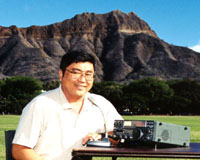 Amateur Radio Articles
Amateur Radio Articles
These are some articles previously written and published by Ron Hashiro, AH6RH. Most have been published in the EARC (Emergency Amateur Radio Club) newsletter "Wireless Dispatch" and may contain a few revisions since the time of original publication. You're welcome to use them with your own amateur radio club newsletter. Please give credit to the EARC Wireless Dispatch.
Enjoy, and feel free to drop me an e-mail if you have any questions.
MFJ Does it Again!
by Ron Hashiro, AH6RH
Let's face it. Deep down inside, most amateur radio operators are gadget freaks. We like to open up the cover, tinker, add on all kinds of plumbing to the radios, and sometimes manage to get on the air without shorting something and starting a fire.
When it comes to learning morse code, there's no difference. How many times have you tried those morse code records, cassette tapes, PC programs, on-the-air sessions? Got bored? Memorized the tapes? Want something else? Keep reading.
With code tapes you can't vary the format. Both your PC and CW radio can't go with you jogging around the block. But, thanks to modern technology, there's a perfect answer for the gadget-minded amateur. It's the MFJ-418 Pocket Morse Code Tutor.
I saw Steve Pang, AH6PB carry one around during Field Day. He got his after seeing Jordan Ige, KH7AC's unit. After seeing what it does, in typical ham fashion, I decided to get one.
MFJ-418The MFJ is essentially a mini-PC programmed as a code tutor with a two-line LCD screen. It's a small unit, about the size of a large pager or a small walkman. You can use it anywhere. To the office, around the home, to the shopping mall while your spouse goes store-hopping.
It has three buttons (Select, Previous and Next) plus one ON/OFF volume control knob. The internal speaker is powered by the 9V battery, or you can plug in any mono or stereo mini headphone.
So what does it do?Using the three buttons, you can scroll through menus that allow you to vary the speed, use Farnsworth code sending, and select from a variety of practice text such as letters, numbers, callsigns, words, QSOs and code groups. You can request it to replay the last exercise text if you wish and you can set it to pause after sending XX number of words.
The real nice feature about the MFJ is that you can vary the content and speed to suit your mood. If you want to try five different practice text in 15 minutes, you're free to choose. You want to speed it up? Slow it down? Change from words to callsigns? Go right ahead. It never tires of these changes.
Hands-on test resultsAfter a few minutes of familiarization, I began copying call signs. I began dreaming of contacting the W1 and K4 call signs I was hearing. It even sent some KH6 and AL7 call signs.
If you get really bored, try listing to 60 WPM. It just seems to buzz by. After that, 35 WPM Farnsworth doesn't seem so bad sent at 3 WPM.
The QSO mode was pretty neat. It simulated a whole QSO from Cindy in Boston to Tom in Phoenix. (She was running a Heathkit HW-8 QRP into a Carolina Windom!) As soon as that was through, it started a QSO between Scott and Jim. No QRM, no QSB. Just pure click-free CW.
Bang for the buck!This unit goes for about $80 each but it's real slick. And, for the ham who relishes tinkering, it just might push you over the edge to get your next license upgrade. And the next. And the next. A much better return on an $80 investment than a bunch of stale code tapes.
So, check it out, good luck and I'll see you at the next VE testing session.
..._._
Permission given to reproduce the above
article in club newsletters provided credit is given
to the author and the EARC
(Emergency Amateur Radio Club) Wireless Dispatch.
Copyright © 1997-2015 Ron Hashiro
Updated: August 31, 2002 DISCLAIMER: Ron Hashiro Web Site is not responsible for the content at
any of the external sites that we link to and therefore
are not necessarily endorsed by us.
